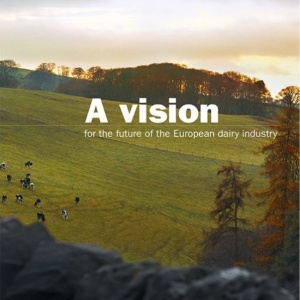
Dairy company Arla has commissioned this report by the Institute for European Environmental Policy, which sets out a vision for how the European dairy sector can become more sustainable in the future, balancing environmental, economic and social considerations.
The key components of the vision include:
- The European dairy sector becomes net zero in emissions. It is not clear how this is to be achieved, although reducing fossil fuel use and eliminating deforestation from the supply chain would be contributing actions. The report suggests that reducing livestock numbers is “only one possible response” to public demands to cut emissions from farming, with improvements in efficiency being another option.
- The sector safeguards biodiversity, e.g. through outdoor grazing and semi-natural habitats on farms. For an overview of the debate around whether biodiversity is best protected by intensive or extensive farming, see the Foodsource building block What is the land sparing-sharing continuum?
- Circular economic models allow the recapture and reuse of materials that would otherwise be wasted. See the FCRN blog A role for livestock in a sustainable food system for a discussion of the “livestock on leftovers” approach.
- Consumers create a demand for (relatively) sustainable products. The report discusses the increasing tendency of younger consumers within Europe to reduce their meat and dairy consumption, but also notes that the European dairy sector will respond to increasing demand for dairy from Asia, Africa and South America. The report also suggests that consumer demand for sustainable products could be fulfilled through a greater share of organic products. Note that organic milk production is not necessarily lower carbon than non-organic production: for example, Table 59 of Williams et al. shows that organic milk has a higher carbon footprint than conventional milk (in the UK), while Figure 4 of Cederberg and Mattsson shows that conventional milk production in Sweden has a higher carbon footprint than organic production.
- Animal welfare is enhanced, with a focus on conditions that allow natural behaviours.
- Greater awareness of nutrition lets consumers choose healthier diets. It is not specified exactly what constitutes a healthier diet - indeed, the report emphasises uncertainty surrounding what a “sustainable, nutritious and healthy diet” would look like. See the Foodsource chapter What is a healthy sustainable eating pattern?
- The dairy sector supports a range of jobs, in part through diversification of farm income streams to include (say) renewable energy and rural tourism.
Read the full report, A vision for the future of the European dairy industry, here. See also the FCRN report Grazed and Confused? and the Foodsource resource Introduction: what are the concerns with meat and dairy, and who are the major stakeholders in the debate?







Post a new comment »